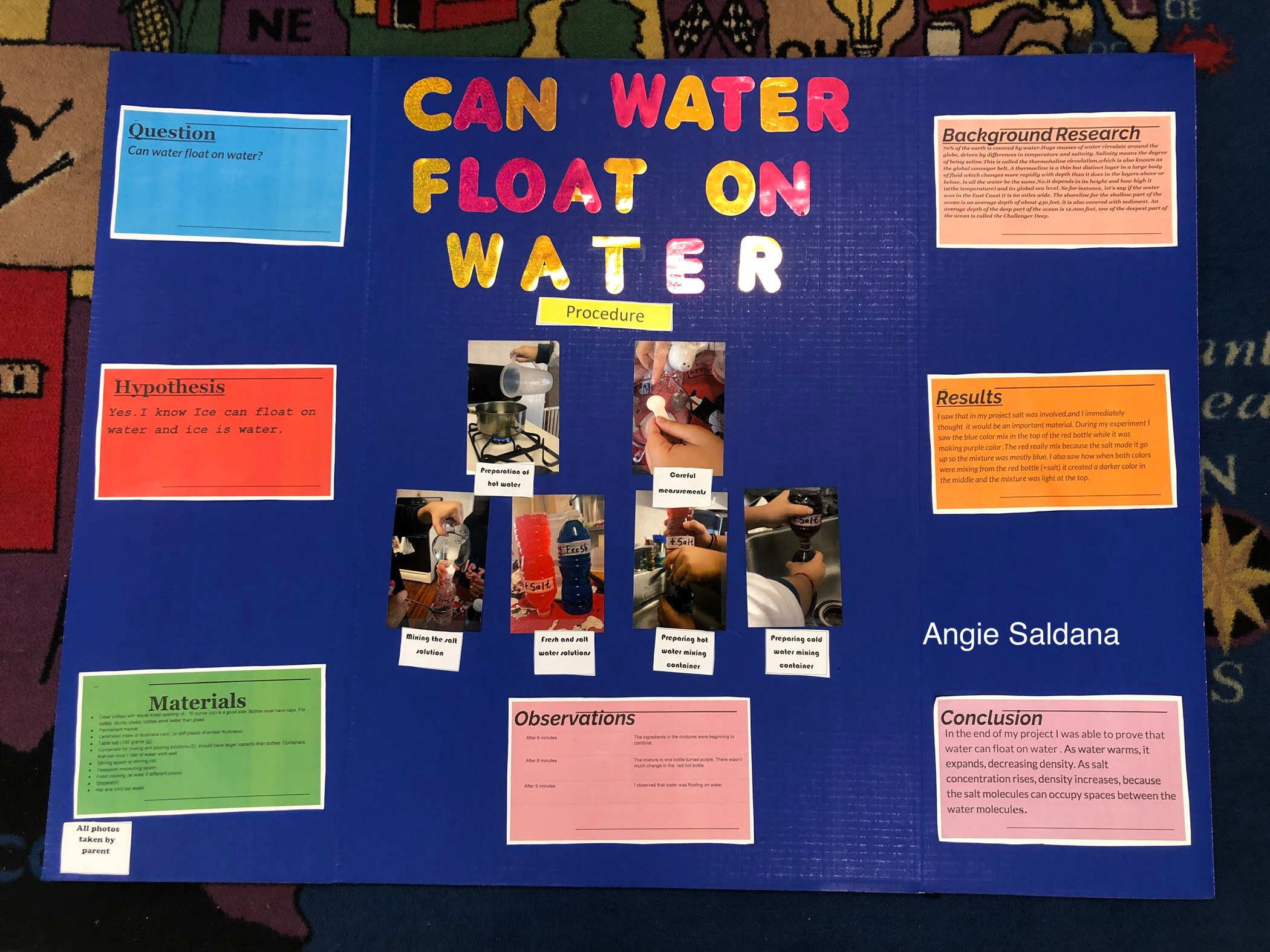Can Water Float on Water?
Abstract:
During my experiment I saw the blue color mix in the top of the red bottle while it was making purple color .The red really mix because the salt made it go up so the mixture was mostly blue. I also saw how when both colors were mixing from the red bottle (+salt) it created a darker color in the middle and the mixture was light at the top.
In the end of my project I was able to prove that water can float on water . As water warms, it expands, decreasing density. As salt concentration rises, density increases, because the salt molecules can occupy spaces between the water molecules.
Bibliography/Citations:
No additional citationsAdditional Project Information
Research Plan:
I am research whether water can float on water. For my project, I need:
●Clear bottles with equal sized opening (4); 16 ounce (oz) is a good size. Bottles must have caps. For safety: sturdy plastic bottles work better than glass. ●Permanent marker ●Laminated index or business card, (or stiff plastic of similar thickness) ●Table salt (150 grams) ●Containers for mixing and pouring solutions (2) ●Stirring spoon or stirring rod ●Teaspoon measuring spoon ●Food coloring (at least 2 different colors) ●Stopwatch ●Hot and cold tap water
My procedure is:
1.Make your ocean water by adding salt and water to the salt mixing 2. Add tap water to the "fresh" mixing container.
3.Add 5 drops of food coloring to each container. Use one color for "+ salt" and a contrasting color for "fresh." For example, red and blue. Note which is which in your lab notebook. (You'll want your notebook handy, but off to the side in case of spills.)
4.Fill a "+ salt" bottle completely full with colored salt water.
5.Fill a "fresh" bottle completely full of colored freshwater.6. .Now comes the tricky part. You are going to invert (turn upside down) one bottle and put it on top of the other, without spilling. It doesn't matter which one you choose to flip over first, because you'll be doing the experiment both ways. It is a good idea to practice this maneuver first with plain tap water until you get the hang of it, so you don't waste your solutions.
7.Observe what happens to the two solutions. Write your observations in your lab notebook. (Make an observation every minute for at least 10 minutes.
8.confirm your results by repeating the experiment. You should perform at least three trials with salt water in the top bottle and fresh water in the bottom bottle, and at least three trials with fresh water in the top bottle and salt water in the bottom bottle.
9.Confirm your results by repeating the experiment. You should perform at least three trials with salt water in the top bottle and fresh water in the bottom bottle, and at least three trials with fresh water in the top bottle and salt water in the bottom bottle. .In the second experiment you'll investigate the effect of water temperature on mixing. This time, you'll use fresh water in both bottles. Label your mixing containers "hot" and "cold."
2.Add hot tap water to one container, and cold tap water to the other. (Note: since you are bound to spill some water, make sure that the "hot" water is not so hot that it would scald.
3.Add about 5 drops of food coloring to each container. Use one color for "hot" and a contrasting color for "cold." For example, blue and yellow. Note which is which in your lab notebook. (You'll want your notebook handy, but off to the side in case of spills.)
4.Completely fill a "hot" bottle with colored hot water. 5.Completely fill a "cold" bottle with colored cold water.
6.Follow the instructions above (step 8 in Salinity and Mixing) for inverting one bottle over the other.
7.As before (step 9 in Salinity and Mixing), observe what happens to the two solutions. Write your observations in your lab notebook. Remember to the note the time as you make your observations.
8.Confirm your results by repeating the experiment. You should perform at least three trials with hot water in the top bottle and cold water in the bottom bottle, and at least three trials with cold water in the top bottle and hot water in the bottom bottle.

